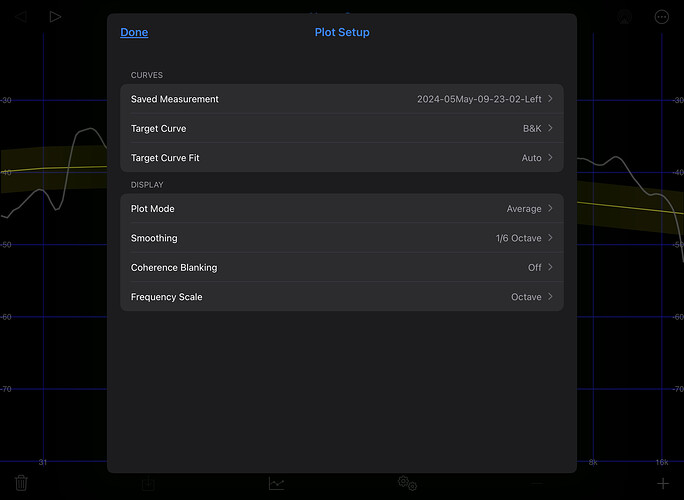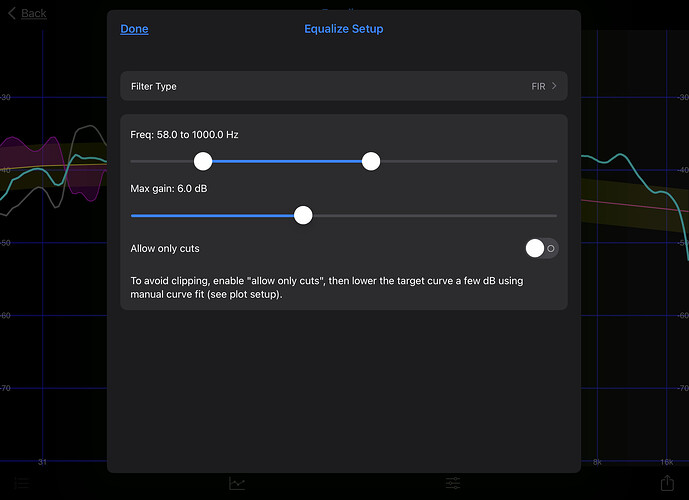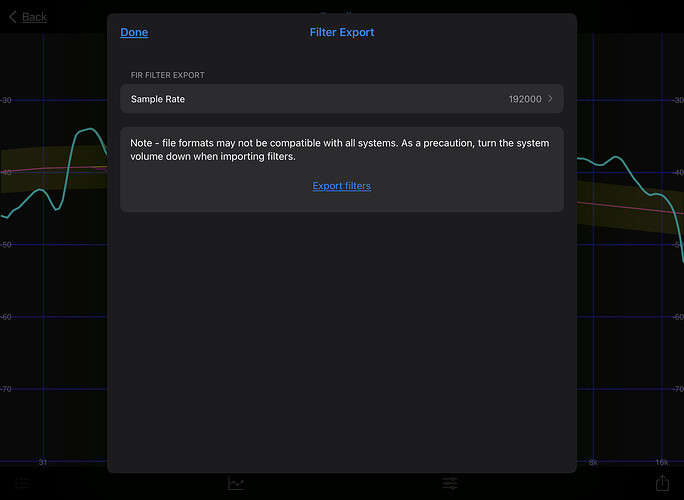So I purchased that app and tested it. The site states that the measurements need to be taken repeatedly ( 3-5 times ) and from multiple locations. And this is despite the fact that I only listen to music from one location? Do I understand correctly that the more measurements the more accurate it will be? For example and 10 measurements? And not from one place?
@Peter_Gregor , measurements is a topic of its own.
Yes, it is better to make several measurements from around one position. For example if you have your preferred listening spot, you take measuremets around where your head is. Sometimes “sweetspot” place is referred to where your nose is (Room correction would have effect in that area only, it may alter sound in other areas)
While you take the measurements one after another, you see it is averaging, that is correct. You may measure left and right channels separatelly.
When you equalise, I would not reccomend to go above 1000Hz and stay within 5-6-7 Db. Equalisation above 1000Hz has its own challenges, as higher frequencies are more directional.
I invite you to research this forum a little and may be internet on this topic, it is huge and requires a bit of time to get hold of what you do. Although, HouseCurve has a very nice step by step…
PS: I often don’t know what I am doing, hehehe, but I try to learn… hm, some times it actually works, my learnings…
Here is a good place to look:
Thank you for your help and time. I’m going to go check it out.
The other point in setting up the sound that you would like is to have your set of “test tracks”. The ones that would contain important frequencies and the ones that you know how they should sound.
I use (and quite like for tests) the digital copy of this: https://www.discogs.com/release/10009073-Various-Are-You-Authentic-AYA-Authentic-Audio-Check
Also I have separate playlist, but it is not scientific…
Important frequencies? Why is it good to have them? It seems quite complicated to me. Where are you from if I may ask? That you would come to set it up for me ![]() . Because these are things I really know nothing about. When i eqqualise shy not recomend to go above 1000hz? More directional? I don’t know what that means either. Sorry for my stupid questions but for me it was just about getting a better sound out of my music. I can see now that it is very much things and concepts that I don’t know about.
. Because these are things I really know nothing about. When i eqqualise shy not recomend to go above 1000hz? More directional? I don’t know what that means either. Sorry for my stupid questions but for me it was just about getting a better sound out of my music. I can see now that it is very much things and concepts that I don’t know about.
I’m afraid that even if I bought a calibration microphone it won’t do me much good until I find out what and how.
Or else I was wondering if I could somehow send you the data from that application and if you could tweak it through the REW program?
I agree room correction is not a subject for a “jump start”. Alas. But no need to make it more complex either.
“Important frequencies” - this would be with compositions making focus on sepcific instruments, almost solos, like pure double-bass, bass-guitar, or violine, or cymbals…
Yep… this one may be more complex. In simple terms, for really low frequencies it does not really matter (much) where your speaker is facing, you can see bass sometimes is pointed towards floor, sometime is looking even up, because for powerful very low frequency wave the speaker direction is really less important. While for the tweeters slight turns in directions change the perception effect, sometimes a lot… down to turn of the head. Problem is when your room is filled with sound these waves start to react with each other
It sounds a little different. I guess I need to get used to it. I can’t play it too loud at the moment because of the neighbours so I don’t know what the outcome will be yet.
But success for me that I managed to at least import that file. ![]()
You can post your HouseCurve screens here or in the housecurve topic for example.
If you took your measurements, these are the settings you may try:
-
Plot Setup
-
Equlize Setup
Note: the starting frequency is 58Hz, is for your speakers.
Application will do necessary calculations for you.
- Export, ideally you make a set of measurements and a filter per channel
Then you can import this in Roon or HQP
But I didn’t set this before the measurement. I just turned off the subwoofer. Error?
Nope. All OK. This setting is to tell to HouseCurve from which frequency to start “euqalizing” algorythm. Your speakers can not do lower than 58Hz, so no point to do anything lower.
Please take a look at the table in PDF manual for some suggestions.
You could try for example the default poly-sinc-gauss-long/poly-sinc-gauss-hires-lp combo. But from there, also poly-sinc-gauss and poly-sinc-gauss-short. And also for comparison check out poly-sinc-short-mp-2s.
Hello. I want ask for an opinion on this amplifier. Do you think it would help to better adjust the digital acoustics of my room without me having to study it?
It is an amplifier Lyngdorf TDAI-1120.
Supposedly it has that room calibration feature.
@Peter_Gregor - TDAI-1120 reviews look attractive. I have no experience with this device so I can not say how much of the “sales pitch” and “bias” is in all these positive reviews.
The room measuring feature in the audio chain is not a new concept, for examle this has been on a market for a while: https://www.minidsp.com/58-products/dirac-series
Thank you very much. I’ll see what users have to say about it. The device was recommended to me by a store in my city, except I see a problem here that is missing a USB DAC which I need since I mainly listen to music from my computer and sometimes also need sound for pc games or youtube videos.



